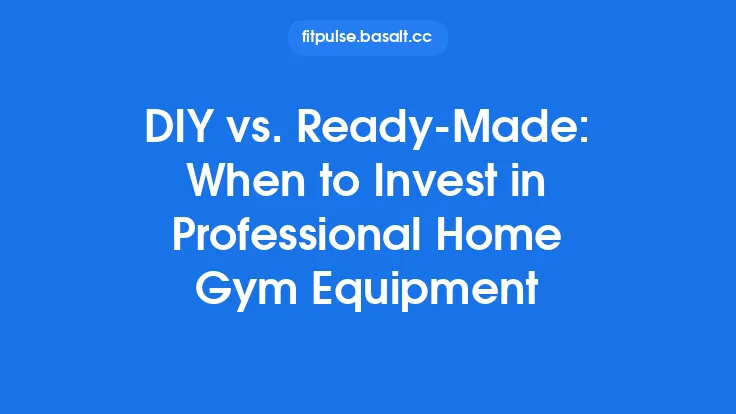When you set out to build a home gym, the excitement of imagining a personal training sanctuary can quickly turn into a maze of choices and price tags. The key to turning that vision into a functional, cost‑effective reality isn’t simply “buy the cheapest gear” or “grab the flashiest machine.” It’s about aligning every purchase with your long‑term fitness goals, usage patterns, and financial parameters. By approaching equipment selection as a strategic budgeting exercise, you can create a gym that grows with you, delivers consistent value, and avoids the common pitfall of accumulating gear that sits idle.
Define Your Fitness Objectives
Before you glance at price lists, write down the specific outcomes you want to achieve. Are you training for a marathon, building strength for powerlifting, improving mobility for daily life, or seeking a balanced mix of cardio and resistance work?
- Primary Goal Identification – Pinpoint the single most important outcome (e.g., “increase squat strength by 30 lb in six months”).
- Secondary Goals – List complementary objectives (e.g., “add 10 minutes of low‑impact cardio three times a week”).
- Time Horizon – Determine whether the goal is short‑term (3–6 months) or long‑term (12 months+).
Having a clear hierarchy of goals provides a decision‑making filter: any piece of equipment that does not directly support a primary or secondary goal can be deprioritized.
Map Goals to Equipment Categories
Once objectives are set, translate them into functional equipment groups. This step bridges the abstract (run a 5 k) with the concrete (what you need to buy).
| Goal Type | Core Movement | Corresponding Equipment Category |
|---|---|---|
| Strength (compound lifts) | Squat, deadlift, press | Power rack, barbell set, weight plates |
| Hypertrophy (isolated work) | Curl, extension, fly | Adjustable dumbbells, cable system, bench |
| Cardiovascular endurance | Running, rowing, cycling | Treadmill, rowing machine, stationary bike |
| Mobility & flexibility | Stretch, joint rotation | Pull‑up bar, yoga mat, foam roller |
| Functional conditioning | Kettlebell swings, farmer’s walks | Kettlebells, sandbag, battle ropes |
By grouping equipment this way, you can see which categories appear across multiple goals and therefore deserve higher priority.
Establish a Tiered Prioritization Framework
A practical method for budgeting is to assign each equipment category to a tier based on its impact and frequency of use.
| Tier | Criteria | Typical Investment |
|---|---|---|
| Tier 1 – Essentials | Directly supports primary goal; used ≥ 3 times/week | Power rack, barbell set, adjustable bench |
| Tier 2 – High‑Impact Add‑Ons | Enhances secondary goals; used 1–3 times/week | Adjustable dumbbells, cardio machine, kettlebells |
| Tier 3 – Supplemental Tools | Provides variety or niche training; used < 1 time/week | Specialty bars, plyometric boxes, resistance bands (as accessories) |
Start by allocating the bulk of your budget to Tier 1 items. Once those are secured and you have a clear sense of usage patterns, you can move on to Tier 2 and eventually Tier 3. This staged approach prevents overspending on low‑frequency gear.
Calculate Cost‑Per‑Workout Value
To keep the budgeting process objective, translate each potential purchase into a “cost per workout” metric.
- Estimate Lifespan – Approximate the number of years the equipment will remain functional for your intended use (e.g., a steel power rack may last 10 years).
- Project Weekly Usage – Based on your schedule, estimate how many sessions per week you’ll use the item.
- Derive Total Sessions – Multiply weekly usage by 52 weeks and the lifespan years.
- Cost‑Per‑Session – Divide the purchase price by total sessions.
Example: A $1,200 power rack expected to last 10 years, used 3 times per week:
Total sessions = 3 × 52 × 10 = 1,560
Cost‑per‑session = $1,200 ÷ 1,560 ≈ $0.77
A low cost‑per‑session indicates a high‑value investment. Compare this figure across potential purchases to prioritize items that deliver the greatest return on your time and money.
Assess Multi‑Functionality and Expandability
Equipment that serves multiple training modalities reduces the need for separate pieces. When evaluating a candidate, ask:
- Can the item accommodate at least two distinct movement patterns?
A power rack with a pull‑up bar and dip attachments covers vertical pulling, pressing, and squatting.
- Is the design modular?
Adjustable dumbbells replace an entire rack of fixed plates.
- Will future accessories be compatible?
A cable pulley system that accepts different handles and bars can evolve with your training.
Prioritizing multi‑functional gear maximizes floor space and budget efficiency without compromising training quality.
Plan for Incremental Acquisition
Even with a tiered system, the total cost of Tier 1 items can be substantial. An incremental acquisition plan spreads out expenses while keeping the gym functional at every stage.
- Phase 1 – Core Strength Base
- Purchase a power rack, barbell, and a set of plates.
- Add a flat bench (often sold as a separate component).
- Phase 2 – Versatile Resistance
- Introduce adjustable dumbbells and a set of kettlebells.
- Acquire a basic cardio machine if cardio is a secondary goal.
- Phase 3 – Specialty Enhancements
- Add a cable pulley system, specialty bars, or a plyometric box.
Each phase should be timed to coincide with a measurable improvement in your training (e.g., after mastering the squat technique, move to Phase 2). This approach also allows you to reassess priorities based on real‑world usage before committing to the next set of purchases.
Incorporate Maintenance and Longevity Costs
The purchase price is only part of the total cost of ownership. Factor in routine maintenance, occasional part replacement, and cleaning supplies.
- Lubrication – Cable machines and moving parts require periodic oiling.
- Wear Items – Bench pads, rubber flooring, and grips may need replacement every few years.
- Calibration – Some cardio machines benefit from annual professional calibration to ensure accurate readouts.
Create a modest annual maintenance budget (typically 2–5 % of the equipment’s purchase price) and include it in your overall financial plan. This foresight prevents unexpected expenses that could derail your cost‑effective strategy.
Leverage Financing and Tax Strategies
If a lump‑sum outlay is challenging, consider financing options that align with your budgeting timeline.
- Zero‑Interest Credit – Some retailers offer promotional financing with no interest for a set period. Use this only if you can repay within the interest‑free window.
- Equipment Loans – Small personal loans can spread payments over 12–24 months, often at lower rates than credit cards.
- Home‑Office/Health Deductions – In certain jurisdictions, a portion of home‑gym expenses may be tax‑deductible if the space is used for a business or health‑related purpose. Consult a tax professional to verify eligibility.
These financial tools can smooth cash flow while preserving the integrity of your prioritization framework.
Monitor Performance and Adjust Priorities
A home gym is a dynamic system. Regularly review how each piece of equipment contributes to your goals.
- Usage Log – Track the number of sessions per equipment weekly.
- Progress Metrics – Correlate strength gains, endurance improvements, or mobility scores with equipment usage.
- Satisfaction Survey – Periodically ask yourself if a piece feels essential, redundant, or underutilized.
If an item consistently falls below a predetermined usage threshold (e.g., < 5 sessions per month), consider reallocating its budget toward higher‑impact gear or selling it to fund future upgrades.
Create a Sustainable Upgrade Cycle
Finally, embed a long‑term upgrade philosophy that respects both performance and finances.
- Set a Review Cadence – Every 12 months, evaluate the gym’s composition against your evolving goals.
- Define Upgrade Triggers – Examples include reaching a strength plateau that requires heavier plates, or a cardio machine that no longer meets desired intensity levels.
- Budget Allocation – Reserve a fixed percentage of annual income (e.g., 5 %) for future upgrades, ensuring that each new purchase is funded without compromising existing equipment.
By treating upgrades as a planned, incremental process rather than ad‑hoc splurges, you maintain a cost‑effective environment that continues to serve your fitness journey for years to come.
In summary, building a cost‑effective home gym hinges on a disciplined, goal‑driven approach: define clear objectives, map them to equipment categories, prioritize through tiered and cost‑per‑session analyses, favor multi‑functional and expandable gear, and adopt a phased acquisition plan that includes maintenance, financing, and regular performance reviews. This systematic methodology ensures that every dollar spent directly supports your fitness aspirations, delivering lasting value and a workout space that grows alongside you.





